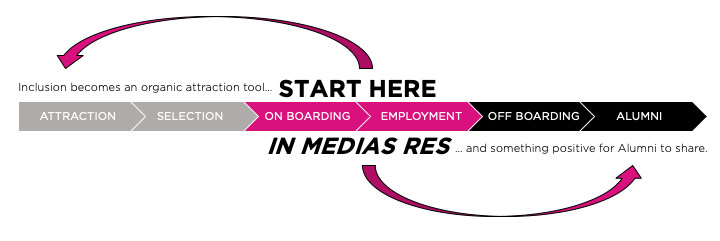
Why your Inclusion Strategy should be present at each stage of the employment lifecycle.
An inclusion strategy should be by definition, inclusive. Not only in the way it fosters an inviting culture of respect for all people, but in the way this culture is fostered across the entire business, and across the entire employment lifecycle. Yet too often, inclusion and diversity strategies are mistakenly developed and targeted only within the recruitment stage of an employee’s experience.
We have previously discussed how it is through the promotion of inclusion (and not diversity targets) that organisations can achieve diverse and flourishing workforces. In this instalment we will examine the importance of this approach across all stages of the employment lifecycle, highlighting the implications for your future talent attraction strategies.
Attraction, selection & on-boarding
Yes of course it is important to have a strong recruiting selection and screening strategy that is free from biases for/against any individual or group of society, and that promotes a broader range of skills and experiences in your teams. But your inclusion strategies shouldn’t end as soon as they’ve signed the employee contract.
As many as 30% of job seekers have quit a job within less than 3 months of starting, and 50% of employees voluntarily leave a job before they reach the 2-year mark. When considered with the fact that employees who say there’s a low level of respect among their teams are 26% more likely to quit their jobs, it shows us that inclusion strategies that promote a workplace culture of welcome and respect are necessary in your on-boarding process as well. Ensuring that new hires feel their decision to join your organisation was the right one will save having to restart the process over again in 3 months.
Off-boarding & Alumni
Also, rather than purely focussing on the diversity of the incoming employees, listen to the employees leaving your organisation as well. Are there noticeable trends in resignations from diverse talent groups? Are they moving to organisations with stronger inclusion and development initiatives? Even if their departure is due to a redundancy or dismissal, your past employees are guaranteed to still be talking about their time with your organisation to their friends, family, future colleagues, perhaps even going as far as to document it online. What they say has immeasurable consequences on your future talent pools. This makes it imperative to help people leave as positive brand ambassadors, not saboteurs.

Employees who have a positive exit experience are 2.9 times more likely to recommend their organisation to others than those who have negative or neutral experiences.
So what story do you want them to be telling? That your diversity strategies allowed your organisation to hire 3:1 women to men over the last 2 years? Or that your organisation’s inclusive culture meant that they felt respected and that their contributions were valued regardless of the circumstances that lead to their leaving? The stats say that it’s the second story that’s more likely to be told, and our money is on that to be a greater attractor for future talent.
Where should you start?
In the writing game there is a term – In medias res, it means to start ‘in the middle of things’, in the thick of the action. In Recruitment, it means that there’s no point selling something to candidates, that the organisation isn’t delivering, that past employees can’t be proud of to tell their friends, peers or other influencers. It goes beyond legally required written policies and corporate commitments, and into cultivating consistent, comprehensive and actionable strategies that cultivate the everyday experience of your employees.

If your inclusion strategy is embedded throughout the employment lifecycle and your organisational culture, not only will it become a more organic attraction tool for future talent pools, it will also serve to improve ongoing employee engagement and performance and extend the average tenure of your current employees.
